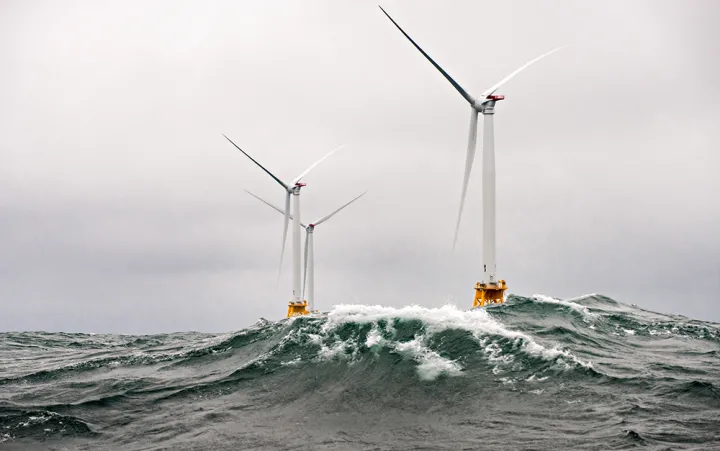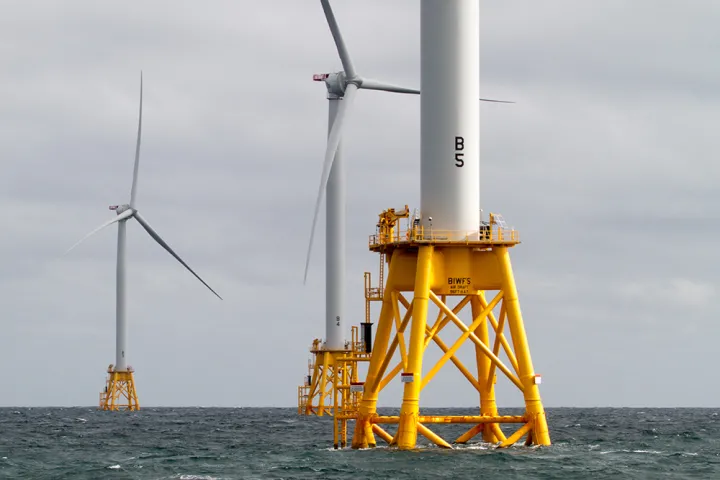An Ocean of Energy: Bringing Offshore Wind to America

Three miles off the coast of Block Island, a roughly ten square mile haven for summer tourists on the New England coast, five enormous white structures tower over the surface of the water. They rise up from the seafloor and stand 560 feet tall (171 m), nearly twice the height of the Statue of Liberty. These behemoths, the first of their kind in the United States, are both heralds and manifestations of the clean energy revolution. And we’re still answering plenty of questions about them.
The ocean is capable of providing us with enormous amounts of clean renewable energy if harnessed correctly—winds, tides and waves all have potential. So far, we’ve been most successful at harnessing the powerful winds blowing over the ocean. Offshore winds provide much more power than winds over land as they encounter fewer barriers, such as mountains and buildings, which reduce their speeds.
Offshore wind power has been harnessed in European waters since the 1990s, but is generally new to the United States. That doesn’t mean there isn’t the potential. The U.S. coastline alone has over 2,000 gigawatts (GW) of wind energy potential—that’s about double the current national demand for electricity. This means that offshore wind has the capacity to replace electricity generated from fossil fuels.
A First in the United States
This is exactly what happened on Block Island. Before the Block Island Wind Farm was completed, the island’s 2,000 permanent residents relied on power from a diesel-fueled power plant. Their energy costs were widely variable and, at times, significantly higher than the U.S. average. Since the wind farm has powered up, the diesel power plant on Block Island has shut down. This one relatively small offshore wind farm is saving an estimated one million gallons of diesel fuel annually. The 30 megawatt wind farm—the first operational offshore wind farm in the United States—consists of five wind turbines which powered up in December 2016 and were connected to the mainland energy grid in May 2017.
This particular offshore wind farm is expected to bring both stable electricity prices for Block Island residents and cleaner air for southern New England. However, some residents are less than thrilled by the new additions to the ocean view and, as with any new industry, offshore wind energy faces challenges. Similar projects have failed to move forward due to resistance from nearby residents, human and environmental impact concerns and regulatory uncertainty.
There are also the challenges of major weather events, like hurricanes, and building these massive structures in deep, offshore water. The industry seems to be up to the challenge, addressing issues through technological advancements such as strengthening the turbine tower, which make the turbines able to withstand hurricane wind and wave forces, and designing turbine foundations that make offshore wind more feasible in deep waters. The Block Island Wind Farm, which used a reinforced building technique called a “jacket foundation,” successfully withstood winter storm Stella in March 2017, and even produced power through most of the storm.
Producing energy with no carbon dioxide (CO2) emissions is certainly a good thing. Our human contributions to global climate change from the burning of fossil fuels—which sends CO2 into the atmosphere, where it traps heat and warms the atmosphere—continue to grow. Global climate change affects the ocean through ocean warming, ocean acidification and sea level rise, just to name a few. Cleaner energy sources, such as offshore wind energy, can help reduce the amount of CO2 blasting into our atmosphere and then, slowly, the impacts from climate change.
Will They Stay or Will They Go?
But what about impacts to ocean animals and ecosystems? Concerns range from the effect of the large structures on migrating birds to underwater noise that may affect sensitive marine species during siting and construction. Luckily we’re not starting from scratch. Studies from Europe, and now Block Island, have found that impacts—when turbines are thoughtfully sited and built—are quite low. Birds, whales and other marine life seem to swim or fly around these man-made ocean structures.
Along the Atlantic coast of the U.S., a variety of whale species make their way through offshore waters, moving between breeding and feeding grounds annually. Because we know when these migrations roughly occur, construction can be timed to avoid them, as was the case in Rhode Island where the construction was halted during the migration period of the highly endangered North Atlantic right whales. “The decision was made to stop pile-driving during right whale migration,” explains Bob Kenney, an emeritus marine research scientist at the University of Rhode Island. He emphasizes that understanding the biology of the animal is key, “I wouldn’t put one in a right whale calving ground or Stellwagen Bank, just to be precautionary.” Additionally, underwater sound and electrical fields emanating from the turbines (important for animals like sharks that rely on electro-reception for navigation) can be reduced using dampening technology. Observers on site can keep an eye out for nearby whales during construction and stop work until they are a safe distance away.
Research done on behalf of the Scottish government found that 99 percent of the bird species studied avoid offshore wind turbines. Modeling and radar technology can help show where birds are flying and even find the optimal height for a behemoth structure like a wind turbine so that it doesn’t block their typical flight path. In the case of the Block Island Wind Farm, researchers collected information about the distribution and population size of bird species found offshore. The impact from offshore wind farms was mostly due to the loss of a foraging area, so learning where particular species likes to feed and rest is an important part of making smart siting decisions.
For some marine fish and invertebrates, the structures may even be a good thing. The construction phase can certainly disrupt ecosystems, but once in place, it’s been shown that these types of large structures actually turn into prime fish habitat. Questions certainly remain about the importance of these new habitats, but research has shown they turn into de-facto marine reserves where fish thrive.
Pulling It All Together
Information about environmental impacts from offshore wind turbines was integrated into the Rhode Island Special Area Management Plan, or SAMP. The SAMP was designed to take into account all different environmental impacts and human uses—along with information about things like average wind amounts, bottom habitat, and water depth—when making decisions about ocean space and resources. By bringing all this information together, the idea is that a well-informed solution will emerge—one that meets the needs of both ecosystems and humans.
It’s not all rosy—many coastal residents still think the expensive structures are an eyesore, and decommissioning may be an issue down the line (the project has a planned 25-year lifespan). Additionally, models like those used in the SAMP are only as good as the information put into them, and the methods of prioritization are inherently human.
Block Island will be an important testing ground and opportunity to gain specific information on the development and impacts of American offshore wind. As more offshore wind projects come online, both construction and wind energy costs are expected to decrease, along with regulatory uncertainty. If the 2015 Department of Energy Wind Vision goal of producing 86 gigawatts of U.S. offshore wind power per year by 2050 is realized, offshore wind would result in “a cumulative reduction of 1.6 billion tonnes of carbon dioxide-equivalents.” Hundreds more offshore wind turbines are currently in the works, including a floating prototype.
“I think they’re worth it,” Kenney says.
This story was made possible by a grant from the Smithsonian Women's Committee. http://swc.si.edu/about-grants



